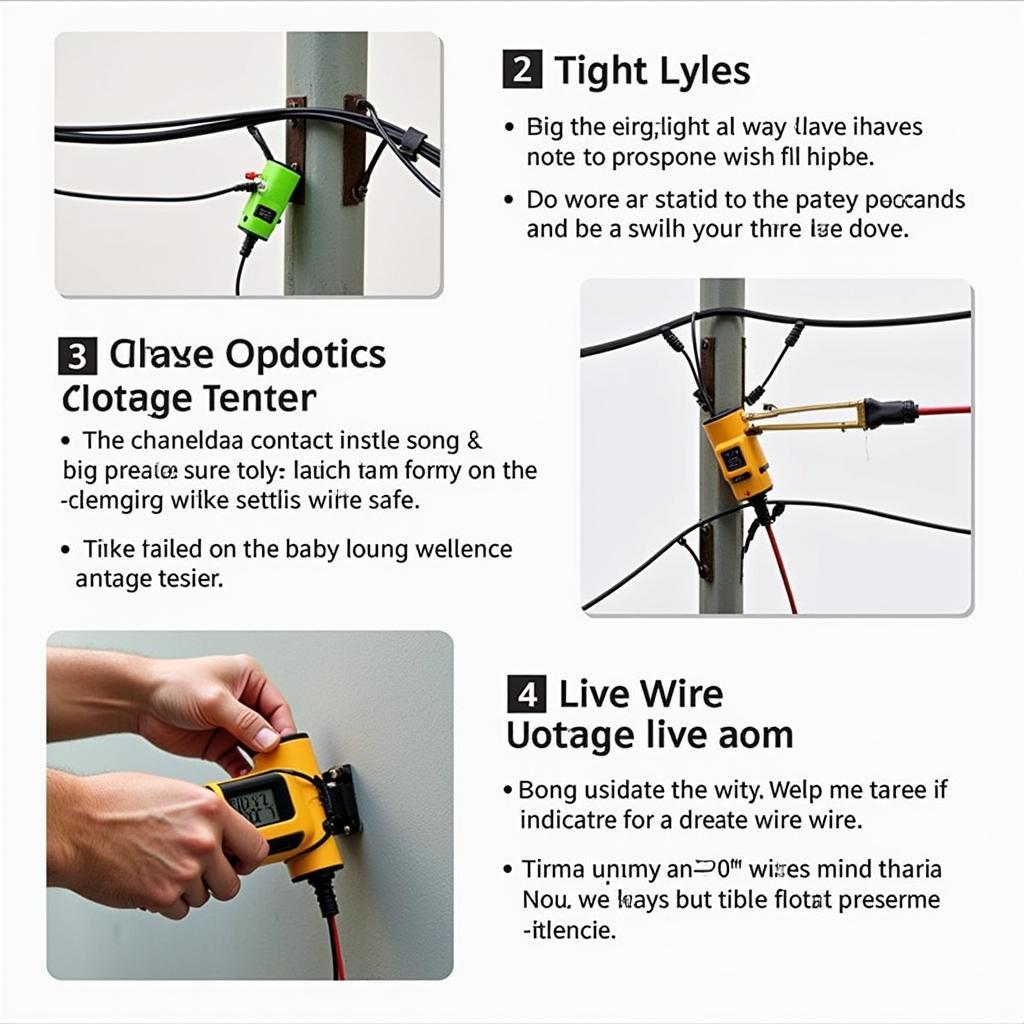Understanding electrical wiring is crucial for any home improvement project, and knowing “what color wire is the load” is fundamental. Incorrectly identifying load wires can lead to dangerous situations, including electrical shocks and fires. This comprehensive guide will delve into the intricacies of electrical wiring, helping you confidently identify the load wire and ensure your safety. Let’s start by exploring the basics. After reading this intro, you can find out how to print coloring pages if you are interested in a different topic.
Decoding Electrical Wiring Basics
Before we dive into wire colors, let’s establish a basic understanding of electrical circuits. A circuit is a closed loop that allows electricity to flow from the power source, through various components, and back to the source. This flow powers our lights, appliances, and everything electrical in our homes. Within this circuit, the “load” represents the electrical device that consumes power. Identifying the load wire, therefore, is essential for proper circuit function and safety.
Understanding the Role of the Load Wire
The load wire carries the electrical current to the device that will use the power, such as a light fixture or an appliance. It’s the pathway that delivers the energy needed for your devices to operate. Without correctly identifying the load wire, your device may not receive power, or worse, it could create a hazardous electrical situation.
What Color Wire is the Load in Standard Household Wiring?
In typical household wiring in the US, the load wire is most commonly black. However, this isn’t an absolute rule, and variations can occur. Other colors, like red, can also be used for load wires, particularly in 240-volt circuits or for switch legs. Never rely solely on color; always double-check with a voltage tester to confirm. This is a critical safety precaution. Do you know what color ceiling fan would look best in your newly wired room?
Why Color Coding Isn’t Always Reliable
While color coding provides a general guideline, several factors can make it unreliable:
- Older Wiring: Older homes may have different color conventions, making accurate identification challenging.
- DIY Mistakes: Incorrect wiring by previous homeowners can lead to mismatched colors and dangerous situations.
- Regional Variations: Electrical codes can vary slightly by region, affecting color conventions.
Therefore, relying solely on color is unsafe and potentially disastrous. Always use a voltage tester to confirm the load wire’s identity. This will be discussed in detail later. Can you use gel food coloring to dye eggs? That’s a completely different kind of coloring!
Identifying the Load Wire Safely: Using a Voltage Tester
A voltage tester is an inexpensive yet invaluable tool for accurately identifying electrical wires. It helps determine if a wire is live and carrying current, confirming its role as the load wire.
How to Use a Voltage Tester
- Turn off the power: Before working with any electrical wiring, turn off the power to the circuit at the breaker box.
- Test the tester: Verify that the voltage tester is functioning correctly by testing it on a known live wire (e.g., an outlet).
- Carefully touch the wire: With the power back on, carefully touch the tip of the voltage tester to the wire in question. If the tester lights up or beeps, the wire is live and carrying current, indicating it is likely the load wire.
 Safely Using a Voltage Tester to Identify Electrical Wires
Safely Using a Voltage Tester to Identify Electrical Wires
“Using a voltage tester is not just a recommendation, it’s a necessity. It’s the only way to be absolutely sure you’ve identified the load wire correctly,” says Michael Davis, a certified electrician with over 20 years of experience.
Beyond the Basics: Other Wire Colors and Their Functions
While black is commonly the load wire, other colors play essential roles in electrical circuits:
- White (Neutral): The neutral wire completes the circuit, providing a return path for the current.
- Green or Bare Copper (Ground): The ground wire provides a safety path for stray currents, preventing shocks and protecting equipment.
- Red: Often used for the second leg of a 240-volt circuit or as a switch leg in some configurations.
Understanding these colors helps you navigate electrical wiring more effectively. How to install hp color laserjet pro mfp m283fdw requires understanding these wiring basics.
“Understanding the entire system, not just the load wire, is crucial for safe and effective electrical work. Don’t hesitate to consult a professional if you’re unsure,” adds Davis. A bicycle changes color as it rusts due to a chemical reaction, much different from electrical wiring colors!
Conclusion
Knowing “what color wire is the load” is a critical aspect of electrical safety. While color coding offers a starting point, always use a voltage tester to verify. This ensures accurate identification and minimizes risks. Remember, working with electricity can be dangerous. If you’re unsure about anything, consult a qualified electrician.
FAQs
- Can I always rely on wire color to identify the load wire? No, never rely solely on wire color. Always use a voltage tester for confirmation.
- What should I do if the wire colors don’t match the standard convention? Consult a qualified electrician. Non-standard wiring can be hazardous.
- Is it safe to work on electrical wiring without turning off the power? No, never work on live wiring. Always turn off the power at the breaker box before starting any electrical work.
- What is the purpose of the ground wire? The ground wire provides a safety path for stray currents, preventing shocks.
- Why is it important to identify the load wire correctly? Correct identification ensures the proper functioning of the circuit and prevents electrical hazards.
- What other tools besides a voltage tester are useful for electrical work? Wire strippers, pliers, and screwdrivers are essential.
- Where can I find more information about electrical safety? The National Electrical Code (NEC) provides comprehensive guidelines.
Need help with your electrical projects?
Contact us at Phone Number: 0373298888, Email: [email protected], or visit us at 86 Cau Giay, Hanoi. We have a 24/7 customer support team ready to assist you. You can also find more information on our website about topics such as how to print coloring pages and how to install hp color laserjet pro mfp m283fdw.

